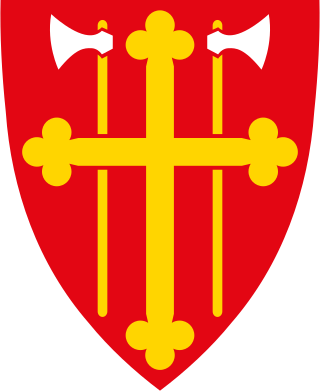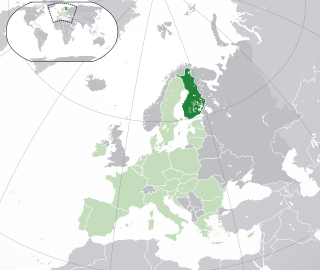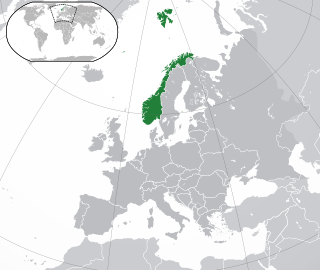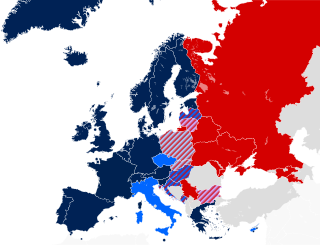
A civil union is a legally recognized arrangement similar to marriage, created primarily as a means to provide recognition in law for same-sex couples. Civil unions grant some or all of the rights of marriage.

The Church of Norway is an evangelical Lutheran denomination of Protestant Christianity and by far the largest Christian church in Norway. The church became the state church of Norway around 1020, and was established as a separate church intimately integrated with the state as a result of the Lutheran reformation in Denmark–Norway which broke ties with the Holy See in 1536–1537; the King of Norway was the church's head from 1537 to 2012. Historically the church was one of the main instruments of royal power and official authority, and an important part of the state administration; local government was based on the church's parishes with significant official responsibility held by the parish priest.
A domestic partnership is an intimate relationship between people, usually couples, who live together and share a common domestic life but who are not married. People in domestic partnerships receive legal benefits that guarantee right of survivorship, hospital visitation, and other rights.
Same-sex marriage has been legal in the Netherlands since 1 April 2001. A bill for the legalisation of same-sex marriage was passed in the House of Representatives by 109 votes to 33 on 12 September 2000 and by the Senate by 49 votes to 26 on 19 December 2000. The law received royal assent by Queen Beatrix of the Netherlands on 21 December 2000 and took effect on 1 April 2001. The Netherlands was the first country in the world to legalize same-sex marriage.

The Civil Partnership Act 2004 is an Act of the Parliament of the United Kingdom, introduced by the Labour government, which grants civil partnerships in the United Kingdom the rights and responsibilities very similar to those in civil marriage. Initially the Act permitted only same-sex couples to form civil partnerships. This was altered to include opposite-sex couples in 2019. Civil partners are entitled to the same property rights as married couples, the same exemption as married couples regarding social security and pension benefits, and also the ability to exercise parental responsibility for a partner's children, as well as responsibility for reasonable maintenance of one's partner and their children, tenancy rights, full life insurance recognition, next-of-kin rights in hospitals, and others. There is a formal process for dissolving civil partnerships, akin to divorce.
Civil partnership in the United Kingdom is a form of civil union between couples open to both same-sex couples and opposite-sex couples. It was introduced via the Civil Partnership Act 2004 by the Labour government. The Act initially permitted only same-sex couples to form civil partnerships, but the law was expanded to include opposite-sex couples in 2019.
Same-sex marriage has been legal in Ireland since 16 November 2015. A referendum on 22 May 2015 amended the Constitution of Ireland to provide that marriage is recognised irrespective of the sex of the partners. The measure was signed into law by the President of Ireland, Michael D. Higgins, as the Thirty-fourth Amendment of the Constitution of Ireland on 29 August 2015. The Marriage Act 2015, passed by the Oireachtas on 22 October 2015 and signed into law by the Presidential Commission on 29 October 2015, gave legislative effect to the amendment. Same-sex marriages in Ireland began being recognised from 16 November 2015, and the first marriage ceremonies of same-sex couples in Ireland occurred the following day. Ireland was the eighteenth country in the world and the eleventh in Europe to allow same-sex couples to marry nationwide.
Same-sex marriage has been legal in South Africa since the Civil Union Act, 2006 came into force on 30 November 2006. The decision of the Constitutional Court in the case of Minister of Home Affairs v Fourie on 1 December 2005 extended the common-law definition of marriage to include same-sex spouses—as the Constitution of South Africa guarantees equal protection before the law to all citizens regardless of sexual orientation—and gave Parliament one year to rectify the inequality in the marriage statutes. On 14 November 2006, the National Assembly passed a law allowing same-sex couples to legally solemnise their union 229 to 41, which was subsequently approved by the National Council of Provinces on 28 November in a 36 to 11 vote, and the law came into effect two days later.
Same-sex marriage is legal in all parts of the United Kingdom. As marriage is a devolved legislative matter, different parts of the United Kingdom legalised at different times; it has been recognised and performed in England and Wales since March 2014, in Scotland since December 2014, and in Northern Ireland since January 2020. Civil partnerships, which offer most, but not all, of the rights and benefits of marriage, have been recognised since 2005. The United Kingdom was the 27th country in the world and the sixteenth in Europe to allow same-sex couples to marry nationwide.
Same-sex marriage has been legal in Denmark since 15 June 2012. A bill for the legalization of same-sex marriages was introduced by the Thorning-Schmidt I Cabinet, and approved by the Folketing on 7 June 2012. It received royal assent by Queen Margrethe II on 12 June and took effect three days later. Denmark was the fourth Nordic country, after Norway, Sweden and Iceland, the eighth in Europe and the eleventh in the world to legalize same-sex marriage. It was the first country in the world to enact registered partnerships, which provided same-sex couples with almost all of the rights and benefits of marriage, in 1989.
Same-sex marriage has been legal in Iceland since 27 June 2010. A bill providing for a gender-neutral marriage definition was passed by the Althing on 11 June 2010. No members of Parliament voted against the bill, and public opinion polls suggested that the bill was very popular. Iceland was the third Nordic country, after Norway and Sweden, the seventh in Europe, and the ninth in the world to legalize same-sex marriage.
Same-sex marriage has been legal in Finland since 1 March 2017. A bill for the legalisation of same-sex marriages was approved by the Finnish Parliament in a vote of 101–90 on 12 December 2014 and signed into law by President Sauli Niinistö on 20 February 2015. Further legislation to harmonise other laws with the legalisation of same-sex marriage was passed in 2016. The law took effect on 1 March 2017. Finland was the twentieth country in the world, the twelfth in Europe as well as the last Nordic sovereign state to allow same-sex couples to marry nationwide.

Lesbian, gay, bisexual, and transgender (LGBT) rights in Finland are among the most advanced in the world. Both male and female same-sex sexual activity have been legal in Finland since 1971 with "promotion" thereof decriminalized and the age of consent equalized in 1999. Homosexuality was declassified as an illness in 1981. Discrimination based on sexual orientation in areas such as employment, the provision of goods and services, etc., was criminalized in 1995 and discrimination based on gender identity in 2005.

The legal status of same-sex marriage has changed in recent years in numerous jurisdictions around the world. The current trends and consensus of political authorities and religions throughout the world are summarized in this article.
Same-sex marriage has been legal in Australia since 9 December 2017. Legislation to allow it, the Marriage Amendment Act 2017, passed the Australian Parliament on 7 December 2017 and received royal assent from Governor-General Peter Cosgrove the following day. The law came into effect on 9 December, immediately recognising overseas same-sex marriages. The first same-sex wedding under Australian law was held on 15 December 2017. The passage of the law followed a voluntary postal survey of all Australians, in which 61.6% of respondents supported legalisation of same-sex marriage.
Same-sex marriage has been legal in Sweden since 1 May 2009 following the adoption of a gender-neutral marriage law by the Riksdag on 1 April 2009. Sweden was the second Scandinavian country, the fifth in Europe and the seventh in the world to open marriage to same-sex couples nationwide. Existing registered partnerships remain in force and can be converted to a marriage if the partners so desire, either through a written application or through a formal ceremony. New registered partnerships are no longer able to be entered into and marriage is now the only legally recognized form of union for couples regardless of sex.

Lesbian, gay, bisexual, and transgender (LGBT) people in Norway have the same legal rights as non-LGBT people. In 1981, Norway became one of the first countries in the world to enact an anti-discrimination law explicitly including sexual orientation. Same-sex marriage, adoption, and assisted insemination treatments for lesbian couples have been legal since 2009. In 2016, Norway became the fourth country in Europe to pass a law allowing the change of legal sex for transgender people based on self-determination. On 1 January 2024, conversion therapy became legally banned within Norway.

Lesbian, gay, bisexual, and transgender (LGBT) rights are widely diverse in Europe per country. 21 of the 36 countries that have legalised same-sex marriage worldwide are situated in Europe. A further 11 European countries have legalised civil unions or other forms of more limited recognition for same-sex couples.
The extension of civil marriage, union, and domestic partnership rights to same-sex couples in various jurisdictions can raise legal issues upon dissolution of these unions that are not experienced by opposite-sex couples, especially if law of their residence or nationality does not have same-sex marriage or partnerships.

LGBT rights in the European Union are protected under the European Union's (EU) treaties and law. Same-sex sexual activity is legal in all EU member states and discrimination in employment has been banned since 2000. However, EU states have different laws when it comes to any greater protection, same-sex civil union, same-sex marriage, and adoption by same-sex couples.









